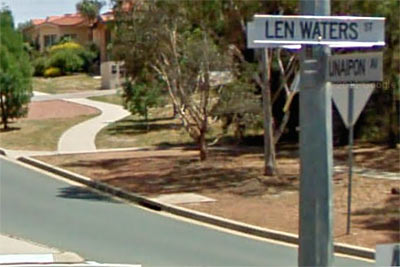Aboriginal timeline: Conflict
Found 44 results for your search. Showing page 2 of 3.
1834
-
Governor Stirling leads a party of men to a site near present day Pinjarra, on the Swan River and attacks 80 Aboriginal people. One of Stirling’s men dies and many Aboriginal people are killed. Official reports put their number at 14 but Aboriginal accounts suggest a whole clan was wiped out in the attack. This became known as the ‘Battle of Pinjarra’. It was an attempt to punish Aboriginal people south of Perth, after conflict with settlers caused the death of a settler in April.
1836
-
Triggered by accounts of the mistreatment of Aboriginal people by British colonists, the British House of Commons orders an inquiry and appoints a select committee to review the treatment of Aboriginal people by British subjects throughout the Empire.
1838
-
Reports of poisoning of Aboriginal people on ‘Tarrone’ near Port Fairy, West Melbourne and ‘Kilcoy’ north-west Moreton Bay. Flour is poisoned and left in shepherds’ huts on ‘Kilcoy’ in the expectation that Aboriginal people now dispossessed of hunting grounds would take it.
1842
-
Governor Bourke of NSW orders the establishment of the Native Police in the Port Phillip district (now Victoria). Aboriginal troopers, trained to track and disperse groups of Aboriginal people, are part of the force. It is disbanded in 1853.
-
Native Police forces operates punitive expeditions and attacks and kills many Aboriginal people on stations. The force is led by European officers. It plays a significant role in later years, in ‘settling’ hostilities in the Macleay and Clarence River regions of NSW. Native Police are used extensively against Aboriginal people in Queensland. They are later disbanded and replaced by civil police, following increasing concern within non-Aboriginal communities concerning the force’s activities. The force was finally disbanded in Queensland in 1897.
1843
-
Responding to a poisoning of Aboriginal people, Aboriginal warrior Multuggerah leads his people, the Jagera, to block the only supply route to the Darling Downs settlement in the Lockyer Valley near Toowoomba, South East Queensland. The settlers attack them in the Battle of One Tree Hill but are defeated. The National Library has a rare eyewitness account of the battle in the form of a pencil drawing, and this history is documented in the book The Battle of One Tree Hill.
1848
-
New South Wales native police troopers are brought to Queensland to kill Aboriginal people and open up the land for settlement.
1857
-
Aboriginal people attack settlers on the Dawson River, Queensland, leading to reprisals by local squatters and police.
1870
-
The Kalkadoon Wars in Queensland last from 1870 to 1890. About 900 Kalkadoon people are killed as they fight to protect their land. The war culminates in the battle of Battle Mountain in 1884. In 1972 Minister for the Army Bob Katter Snr. names an army helicopter ‘Kalkadoon’ at a ceremony with Kalkadoon people in Mt. Isa in recognition of their fighting spirit.
1877
-
Settlers in the Daintree River Area of Queensland are killed by Aboriginal people.
1890
-
Jandamarra, an Aboriginal resistance fighter, declares war on European invaders in the West Kimberley and prevents settlement for six years.
-
For eight years the Western Australian conflict rages in Western Australia.
1897
-
Jandamarra, Kimberley’s resistance fighter, is shot and 19 former Aboriginal prisoners, whom he had freed and were fighting with him, are also shot and killed.
1900
-
Part-Aboriginal man Jimmy Governor goes on a rampage killing 10 people. He was captured and hanged at Darlinghurst Gaol, NSW, on 18 January 1901.
1902
-
During the Boer War about 50 Aboriginal trackers are summonsed by the British forces in South Africa to join the war to locate Boer fighters. When Australian forces withdraw later that year, the trackers are thought to have been left behind.
1914
-
Aboriginal people serve in the war despite the Defence Act 1909 which prohibits any person not of ‘substantially European’ origin from serving. Aboriginal soldiers are among Australian troops at Gallipoli.
1939
-
World War II begins. Although Aboriginal people are not recognised as citizens, two Aboriginal military units are established and some Aboriginal people serve in other sections of the armed forces as formally enlisted soldiers, sailors or airmen. Aboriginal people serve in Europe, the Middle East, the Pacific and New Guinea.
1942
-
Darwin is bombed by the Japanese. In Arnhem Land, Aboriginal people make up a special reconnaissance unit in defence of Australia. Northern Territory Aboriginal missions are evacuated. Many Aboriginal people evacuated after the bombing are transferred to ‘control camps’ in Victoria, South Australia or New South Wales and some never return. Restrictions are placed on Aboriginal movement, especially of women.
-
19-year old Len Waters becomes the first Aboriginal military pilot to be accepted into the Royal Australian Air Force (RAAF). [1] He is also the only Aboriginal fighter pilot to serve during World War II. Len left the air force in 1946 and died in 1993 aged 69. Streets in ACT and Sydney bear his name, and in October 2020 the Department of Defence named a building at RAAF Base Williamtown (30 kms north-east of Newcastle, NSW) after him. [2]

Len Waters Street in Ngunnawal, Australia Capital Territory.
1943
-
Formation of the Torres Straight Light Infantry Battalion. 880 men enlist, about 90% of the total male population of the Islands. Their discipline and work ethic sees them in high regard among fellow soldiers. In small groups they patrolled the islands close to Papua New Guinea monitoring the movements of Japanese forces. Yet, they only receive half of the wages of their peers.
References
View article sources (2)
[1]
'First Indigenous military pilot remembered', Koori Mail 525 p.15
[2]
'Building named to honour Indigenous fighter pilot', Department of Defence, 27/10/2020, available at news.defence.gov.au/national/building-named-honour-indigenous-fighter-pilot; thanks to my subscriber
Flurgen for letting me know.
